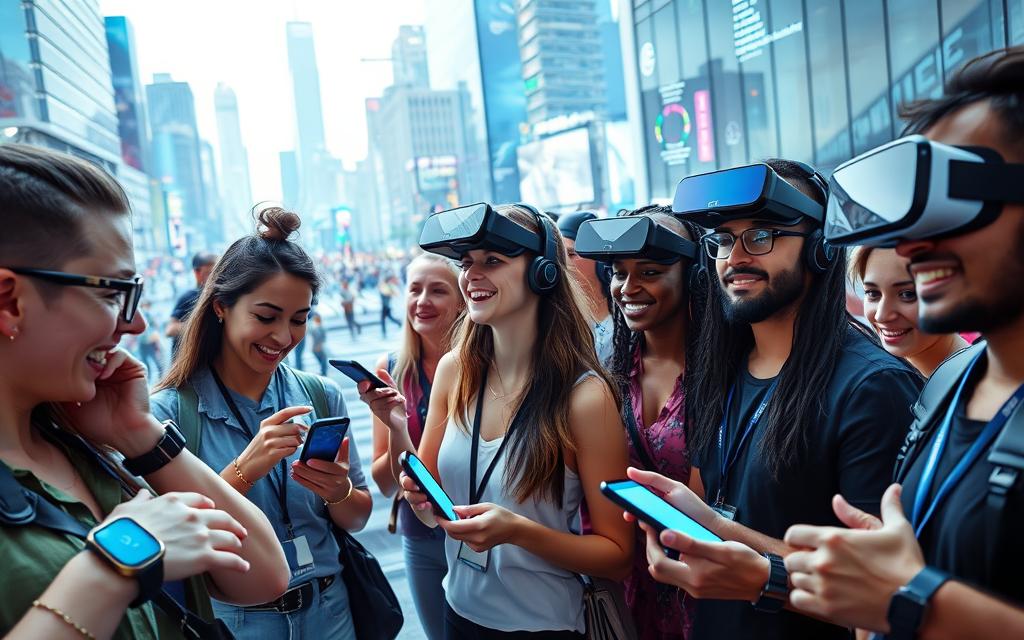Did you know the wearable tech market in the U.S. is expected to hit USD 19.92 billion in 2023? It’s growing fast, with a yearly growth rate of 12.8% from 2024 to 2030. Clearly, wearable gadgets are becoming a big part of our lives, especially for health and fitness.
More people are buying these smart devices, giving the U.S. a 27.7% slice of the global market. The recent pandemic has pushed this growth even faster. Gadgets like Fitbit and smartwatches are now key for keeping track of our health. This article will look into the newest wearables and their big impact on technology.
The Rise of Wearable Technology in the U.S.
The look of wearable technology in the U.S. has changed a lot. Today, we see more wearable electronics and smart devices than ever before. People wear them all over their body, fitting them into their daily lives easily. Features like health trackers and updates are now normal, showing how useful these devices can be.
What Defines Wearable Technology?
Wearable technology means electronic devices you can wear. They come with many uses, from tracking fitness to watching over your health. They can check your heart rate, how many steps you take, and how well you sleep. This makes wearables a great choice for people who care about their health. They are made to be comfortable and easy to use, so lots of people like them.
Historical Context of Wearable Devices
Wearable technology started in the 1970s with simple gadgets like calculator watches. Over the years, it greatly improved, especially in the 2010s. This is when companies like Apple and Fitbit really pushed the market. We started seeing advanced fitness trackers and smartwatches, which became essential in our daily lives. The growth of wearable electronics has massively influenced how people in the U.S. view technology, keeping their interest alive.
Popular Types of Wearable Devices
The wearable tech scene is constantly changing with new devices coming out. There are fitness gadgets for those who love to be active. There are also devices aimed at monitoring health conditions. Every type of wearable has its own special features. These features help people use technology in a closer and more effective way.
Fitness Trackers and Smartwatches
Fitness gadgets, like trackers and smartwatches, are very popular. They mix ease of use with useful features. They keep track of steps, heart rate, and sleep quality. Products like the Fitbit Charge and Apple Watch help people stay active. They give useful information about your fitness routine. Smartwatches are not just for fitness; they also have features for daily life. They keep you on top of your notifications and favorite apps, in style.
Health Monitoring Devices
Health wearables do more than just fitness tracking. They focus on managing health. For instance, the Oura Ring and glucose monitors watch over health issues like diabetes. They give users data in real-time. This helps people know more about their health, make changes, and get advice from doctors when needed.
Smart Glasses and AR Headsets
Wearables are not all about fitness and health. Smart glasses and AR headsets offer new ways to mix digital elements with the real world. Devices like Google Glass and Microsoft HoloLens are changing the game. They make digital interactions part of the physical world. As this tech gets better, it’s being used in gaming, learning, and work training.
Key Players in the Wearable Market
The wearable tech industry thrives on new ideas and competition. Big names like Apple, Fitbit, Samsung, and Garmin offer cool features that shape the market. Understanding their roles helps us see consumer choices and new trends.
Apple: Leading the Charge
Apple is a top player in wearable tech, mainly due to the Apple Watch. This device tracks your fitness and health. Plus, it’s a smartwatch that lets you manage notifications, make contactless payments, and work seamlessly with other Apple products. Apple sets the bar high with its focus on design and functionality.
Fitbit’s Influence on Fitness Trackers
Fitbit is big in the fitness tracker scene with its user-friendly devices. It promotes staying active with simple trackers and advanced smartwatches. Fitbit focuses on health, offering insights on exercise, sleep, and heart health, all at a good price.
Innovations from Samsung and Garmin
Samsung and Garmin bring new features to their wearables. Samsung’s gadgets are stylish and track your health, attracting many users. Garmin targets the sporty crowd, especially those who love the outdoors. Their products offer precise GPS tracking, fitness tips, and sport-specific metrics.
| Brand | Focus Area | Key Features |
|---|---|---|
| Apple | Smartwatches | Health tracking, notifications, payments |
| Fitbit | Fitness Trackers | Activity tracking, sleep analysis |
| Samsung | Smartwatches | Health metrics, stylish design |
| Garmin | Sports & Fitness | GPS tracking, athletic coaching |
Health & Wellness Applications of Wearables
Wearable technology has truly changed how we look at health. It gives users tools to make their wellness journey better. These tools help with monitoring chronic conditions, mental health, and sleep, aiming to boost health and promote a healthier life.
Monitoring Chronic Conditions
Thanks to advanced tech, health wearables let users keep an eye on chronic illnesses like diabetes and heart disease. Gadgets such as the Apple Watch and Fitbit models can track your heart rate and blood sugar. This helps people intervene early and manage their health better, giving them a sense of control.
Mental Health and Wearable Tech
Recently, wearable tech has started focusing on mental health. Now, gadgets often have tools to manage stress, monitor moods, and offer guided meditation. These features give people insights to manage their mental health and lead a more balanced life.
Sleep Tracking Trends
Many wearables now pay close attention to sleep. Brands like Whoop and Garmin use advanced sensors to study sleep habits. This helps people improve their sleep quality, which is key for overall health, productivity, and mental clarity.
Consumer Adoption Patterns
Various factors shape how people start using wearable technology. These include age, reasons for buying, and the types of gadgets they choose. Knowing who buys wearable tech and why helps us understand how different people use it.
Demographics of Wearable Tech Users
People of all ages use wearable tech, but it’s most popular among younger adults. Millennials and Gen Z love using it for staying fit and keeping up with new gadgets. Meanwhile, more older adults are using wearables too. They use them to check their health and handle long-term health conditions. This shows that wearable tech is becoming popular with everyone, no matter their age.
Key Motivations Behind Purchases
People buy wearable tech for many reasons. Here are a few:
- Health improvement: Tracking health and activity makes people want to use wearables.
- Convenience: They make it easy to see messages and health info without a phone.
- Aspirational lifestyle: Brands like Apple and Fitbit encourage a healthy, active life, which attracts buyers.

The Role of Data Privacy in Wearable Tech
Wearable tech is becoming more popular, and with it comes a focus on data privacy. As more people use fitness trackers, smartwatches, and health monitors, their information is very valuable. It’s important for users to know how these devices collect and use their data. This helps them make smart choices about the technology they use.
Understanding Data Collection Practices
These devices gather lots of data, like heart rates, sleep habits, and where you go. This information can make the devices more useful and give you insights into your health. But, it’s important that companies are clear about how they use this data. They need to tell users what data they collect, how they keep it safe, and if they share it with others or use it for ads.
Balancing Utility and Privacy Concerns
Finding a balance between cool features and data privacy is tough for companies. Brands like Apple and Fitbit work hard to earn users’ trust with strong privacy policies. They talk to their customers about privacy to build trust. This trust helps people feel safe using wearable tech, knowing their data won’t be misused.
Future Trends in Wearable Tech
Wearable technology is changing fast, thanks to new materials and designs. Innovations are making gadgets look and work better in our lives. AI and machine learning will be key in improving health and wellness support.
Advancements in Materials and Design
New, lightweight, and flexible materials are on the horizon. These improvements will make wearables more comfortable and functional. They will fit better into our daily looks, encouraging more people to use them.
The Integration of AI and Machine Learning
Adding AI and machine learning to wearables is a game-changer. They will make health tracking more personal and accurate. These devices will not just count steps but also give health tips. This change will help spot health risks early on.
The Impact of Wearables on Fitness and Lifestyle
Wearable technology has changed how we take care of our health and live our daily lives. These gadgets let people customize their exercise plans to fit what they need and want. With the latest features, fitness wearables give helpful tips. They make sticking to exercise plans easier and more fun.
Personalizing Workout Routines
With fitness wearables, it’s easy for anyone to shape their exercise routine. These gadgets keep an eye on your heart rate, how many calories you burn, and how much you move. This helps you create workouts that are both effective and fun. By checking your progress, you can change your plan as you go. This makes sure each exercise helps you reach your fitness goals.
Tracking Progress and Goals
One big plus of fitness wearables is how they help track your progress. You can see how far you’ve run or if you’ve reached your heart rate goal. Seeing progress helps you feel good about your efforts. Being able to set clear goals and see how well you’re doing with a wearable device is key. It helps people stick with healthier choices and be more active.
Challenges Facing the Wearable Technology Industry
The wearable technology industry is booming but faces big hurdles that slow its growth. A major issue is battery life. Devices often run out of power quickly, making users charge them often. This is a big problem for those using wearables to track their health or fitness all day.
Battery Life Limitations
The life of a battery is key for user happiness with wearable tech. People want batteries that last long and don’t need many charges. While companies are working hard to make better batteries, finding the right mix of battery life and features is hard. For more people to use wearables every day, the batteries need to last longer.
Market Saturation Concerns
As more products fill the market, it’s hard for companies to stand out. With so many brands fighting for attention, buyers can get confused. To shine in this crowded space, being innovative and creating unique user experiences is vital. Brands need to focus on what makes their products special and tackle the ongoing battery issue.
Conclusion: The Future of Wearable Tech in America
The wearable tech scene in the U.S. is set to change a lot soon. Innovations will keep popping up, making wearables a key part of our lives. Companies are focusing on personalized health tools to improve how we use these gadgets and meet what customers want.
Expected Growth and Evolution
Looking ahead, wearable gadgets will pay more attention to what users need and how they work. They’ll use smart technology like AI to help with health tracking. This will let people know more about their health and blend tech more into our lives.
Encouraging Responsible Technology Use
As wearables grow, it’s important to use them wisely. Concerns about keeping data safe are big, so makers need to earn users’ trust by being clear about how they use data. People want gadgets that improve their lives but also keep their info safe. So, as wearable tech advances, focusing on innovative and ethical practices is key. This ensures tech that matches our values, promoting a healthier digital world.




